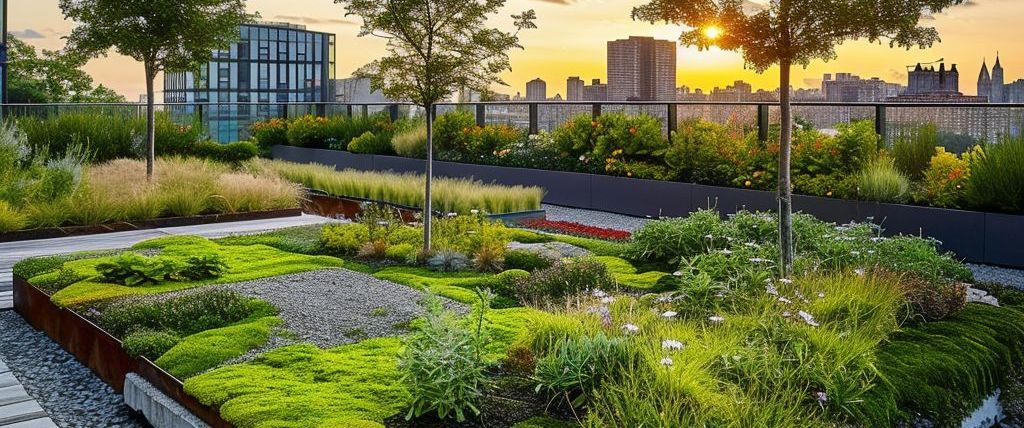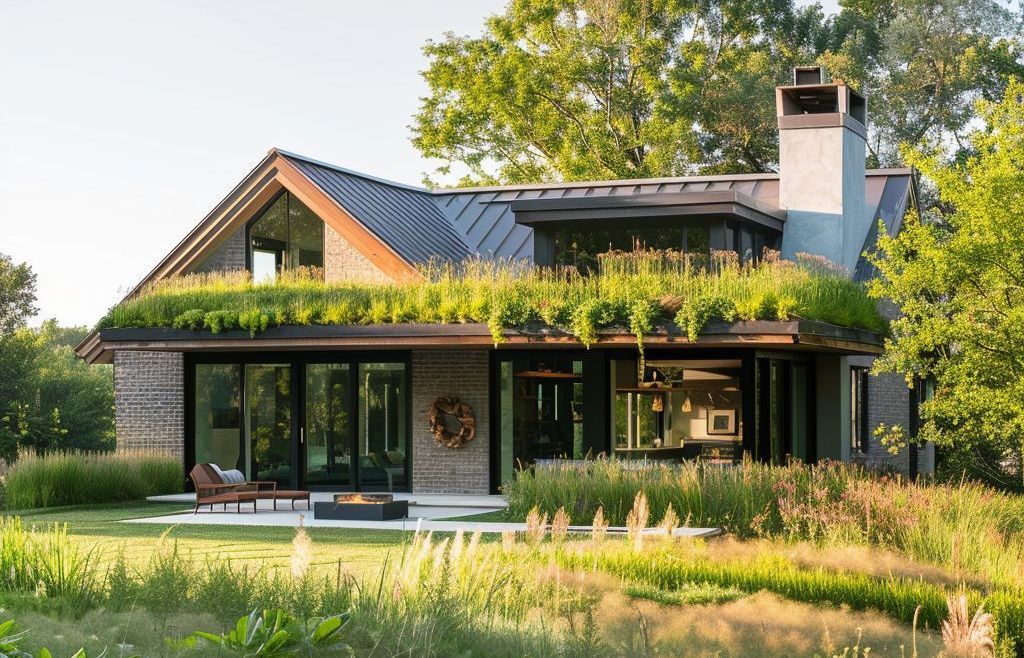How to Maintain and Care for Green Roofs
If you're looking to dive into the world of green roofs, you've made a fantastic choice. Minnesota's weather, with its hot summers and cold winters, puts unique demands on buildings. This often calls for the need for green roofs in the state.
Green roofs
bring a splash of nature to urban landscapes. They create sustainable, eco-friendly spaces that benefit both you and the environment.
So, what exactly are green roofs? They are roofs covered with vegetation, a growing medium, and a waterproof membrane. They help reduce heating and cooling costs, extend roof life, and support local wildlife.
With Minnesota's unique climate, maintaining a green roof might initially seem daunting. But don't worry, we're here to guide you through every step.
Benefits of Green Roofs
Green roofs bring many benefits to your Minnesota property, making them an investment worth considering.
✔️ Enhance Energy Efficiency
Green roofs are a game-changer for your building's energy use in Minnesota. They act as natural insulators, keeping your property cozy during the cold winters and cool in the sultry summers.
This translates to noticeable savings on your energy bills, a direct benefit to your pocket and the planet.
✔️ Support Local Wildlife
Introducing a green roof to your urban space creates a
sanctuary for birds
, bees, and butterflies.
This small ecosystem plays a vital role in preserving local biodiversity and offers a much-needed habitat for various species, enhancing the ecological footprint of your property.
✔️ Reduce Rainwater Runoff
One of the standout benefits of green roofs is their ability to
soak up rainwater,
significantly reducing runoff. This is especially important in areas at risk of flooding or where the stormwater system is under pressure.
Green roofs help alleviate these issues by capturing rainwater, creating a more sustainable urban environment.
✔️ Improve Air Quality
The plants on green roofs work tirelessly to filter pollutants and carbon dioxide from the air. This natural purification process improves air quality around your property, ensuring the air you breathe is cleaner and healthier.
✔️ Reduces Noise Pollution
Green roofs act as
natural sound insulators
. The layers of soil, plants, and additional materials absorb, reflect, and deflect sound waves, significantly reducing noise pollution.
This makes them particularly effective in urban environments, where they can create quieter, more peaceful spaces amidst the hustle and bustle of city life.
✔️ Extend Roof Lifespan
Green roofs offer remarkable protection for your roofing material, shielding it from
UV radiation
and extreme temperature changes. This added layer of protection can double or even triple the lifespan of your roof, making green roofs a wise investment for the longevity of your property.
The Basics of Green Roof Maintenance in Minnesota
Maintaining a green roof in Minnesota is about understanding the local climate and adapting your care routine accordingly. Regular tasks like watering, choosing the right plants, weeding, and replacing plants as needed are essential to a thriving rooftop garden.
Watering Wisely
In Minnesota, watering your green roof requires a balance. Your plants need extra attention during dry spells, but be careful not to overwater. A good rule of thumb is to check the soil's moisture level.If the top inch is dry, it's time to water. Consider installing a drip irrigation system for consistent moisture, especially during the unpredictable Minnesota summers. Remember, too much water can lead to root rot and other diseases, so moderation is key.
Selecting the Right Plants
Choosing plants that can withstand Minnesota's unique climate is vital. Look for drought-tolerant species that can also handle the cold winters. Native plants are usually a good bet, as they adapt to local conditions and require less maintenance.Consulting a professional can help you select the right mix of sedums , grasses , and wildflowers to flourish on your green roof, ensuring it remains vibrant and resilient year-round.
Regular Weeding
Regular weeding is needed for the health of your green roof. Weeds can quickly take over, competing with your chosen plants for nutrients and water. Incorporating a routine to pick weeds and applying preventive herbicides like preen pre-emergent can significantly reduce maintenance efforts.These measures not only keep your green roof looking tidy but also prevent the establishment of invasive species that could threaten its biodiversity and functionality.
Replacing Plants as Needed
No matter how carefully you select and tend to your plants, some may not survive the harsh Minnesota weather. It's essential to regularly assess your green roof's vegetation, replacing dead or struggling plants to maintain its health and aesthetic appeal.This process allows you to introduce more resilient species or varieties better suited to current conditions, ensuring your green roof continues to thrive.

Seasonal Maintenance Tips
Caring for your green roof in Minnesota means adapting to the changing seasons. Each brings its tasks to ensure your green oasis thrives year-round.
Here's a simple, month-by-month guide to keep you on track:
Spring (March-May)
As the snow melts and signs of life reappear, it's time to gear up for spring. Start by clearing debris that winter left behind. Early April is perfect for inspecting your drainage to prevent waterlogging.As the weather warms, gradually water your plants, especially if rainfall is scarce. Late May is ideal for adding new plants or seeds , giving them an entire season to establish.
Summer (June - August)
Summer in Minnesota can swing from hot to cool. Monitor your green roof's moisture levels closely ; watering may need adjusting based on rainfall and temperatures.Regular weeding will keep invasive species at bay and your plants healthy. Also, check for pest infestations regularly, as early detection can prevent widespread damage.
Fall (September - November)
Fall is preparation time for the colder months. Begin by reducing watering as the temperatures drop, but don't let your plants dry out. Remove any dead or dying plants and replace them as needed with hardy species that can withstand Minnesota's winter.Applying a thin layer of mulch can help protect roots from freezing temperatures.
Winter (December - February)
Maintenance during winter is minimal, but pay attention to your green roof. Check after heavy snowfalls to ensure no excessive weight on your roof.It's also an excellent opportunity to plan for the coming year, considering what worked well and what might need adjustment.

Professional Help: When to Use a Pro
Knowing when to call in a pro for your green roof in Minnesota can save you time and headaches. If you're selecting plants, consider our help to choose drought-tolerant varieties that thrive in our local climate.
Also, if your green roof faces persistent issues like poor drainage or widespread disease, or if you're planning a major renovation, it's time to consult an expert. If you’re a property manager with a building in Minneapolis that has a green roof, don't hesitate to reach out for professional guidance.
Investing in professional care can prevent costly mistakes and keep your green oasis flourishing for years.
Green Up Your Space with KG Landscape
Embarking on your green roof journey in Minnesota is a rewarding endeavor. Your rooftop will thrive with the proper care—choosing drought-tolerant plants, keeping up with regular weeding, and replacing plants when necessary.
Remember, it's not just about the beauty; it's about creating a sustainable, energy-efficient space that benefits you and the environment.
Ready to take your green roof to the next level or need expert advice to get started? Contact KG Landscape today. Our team of professionals are here to help you every step of the way, ensuring your green roof is a vibrant, flourishing addition to your Minnesota home or business.










